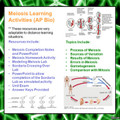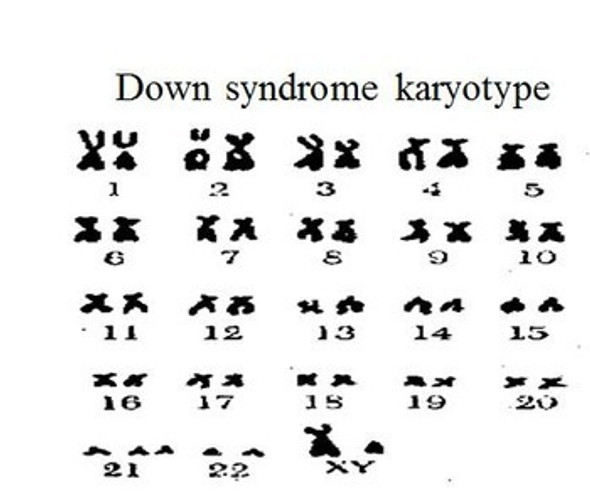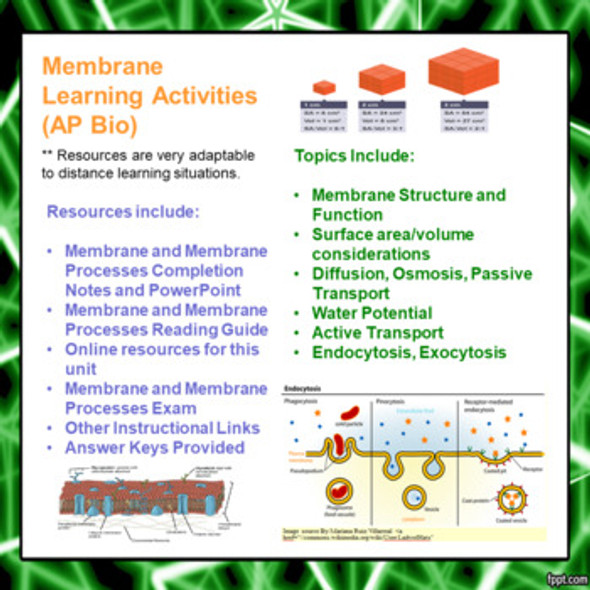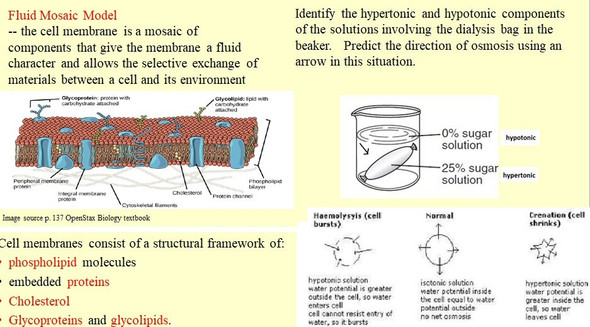Meiosis Learning Activities for AP Biology (Distance Learning)
- Bulk Pricing:
- Buy in bulk and save
- Contributor:
- Monday's Rescue
- Grade Level:
- 9-12
- Product Type:
- Learning Package (Notes, PowerPoint, Lab, Homework)
- File Type:
- doc, pdf, ppt
- Pages:
- 41
- Answer Key:
- Yes
Description
This zip file contains many different activities (40 pages of student handouts and 2 PowerPoints with a total of (62 slides) which can be used to compose a unit for AP Biology or advanced Biology students on Meiosis/Gametogenesis). Concepts dicussed and evaluated include the process of meiosis, results of meiosis, sources of variation such as crossing over, some consequences of errors in meiosis (Down syndrome, nondisjunction, etc) and specifics about oogensis and spermatogensis are presented. Two lab activities, a 51 question homework assignment and a comprehensive examination and key for the unit is also included.
This lesson packet contains a listing of the learning goals, common core learning standards, NGSS learning standards and the AP Biology performance indicators addressed in these materials. These are included in the packet and at the end of the description of this lesson. The learning guides/assignments contain links to online resources to support student learning.
Most documents are included in both word as well as pdf to allow editing for specific teacher needs. These learning materials are well suited for a distance learning situation.
Answer keys are included for all activities, with the exception of portions of lab activities where student answers may vary. All lab activities require easily obtainable materials, with the exception of the Sordaria Crossing Over Lab. A PowerPoint which can be used in replacement of the Sordaria culture is included.
The specific contents of the learning package includes the following items (the page count for these items are actual student handouts as answer key page counts are not included):
-- Meiosis and Sexual Life Cycles Objectives (2 pages) in word and pdf format
-- Meiosis and Gametogenesis Completion Cloze notes (17 pages) in word and pdf format
-- PowerPoint to accompany the Meiosis and Gametogenesis Completion Notes (47 slides)
-- Genetic Mapping Activity with Key in word and pdf format (6 pages)
-- PowerPoint to accompany the Genetic Mapping activity (useful if Sordaria cultures are not available) (15 slides)
-- Meiosis Homework with Key (51 mixed format questions) in word and pdf (8 pages)
-- Modeling Meiosis Lab with Key in word and pdf (4 pages)
-- Meiosis Test (12 completion, 18 multiple choice and 1 short answer question) with Key in word and pdf format (5 pages)
Meiosis and Sexual Life Cycles Objectives ETS
Enduring Understanding
IST-1 Heritable information provides for continuity of life.
Learning Objectives
IST-1.F Explain how meiosis results in the transmission of chromosomes from one generation to the next.
IST-1.G Describe similarities and/ or differences between the phases and outcomes of mitosis and meiosis.
IST-1.H Explain how the process of meiosis generates genetic diversity.
Meiosis and Gametogenesis Learning Goals local)
Upon completion of this unit the student will be able to:
1. explain how the processes of meiosis and fertilization ensure genetic diversity in sexually reproducing organisms.
2. explain how meiosis reduces the chromosome number by one-half to produce haploid gametes.
3. explain how fertilization increases genetic variation in populations by providing for new combinations of genetic information in the zygote and restoring the diploid number of chromosomes.
4. recognize that some genetic information is retained in gametes due to the replication and pairing of homologous chromosomes.
5. explain how crossing over during meiosis increases genetic variation in the resultant gametes.
6. construct an explanation using representations with annotations how DNA in the form of chromosomes is transmitted to the next generation via meiosis followed by fertilization.
7. explain the connection between meiosis and increased genetic diversity necessary for natural selection.
8. distinguish between ascospores in sordaria exhibiting normal meiosis versus crossing over
9. determine the map unit distance of a gene to centromere based on the crossover frequency in sordaria.
NGSS Standards
Students who demonstrate understanding can:
HS-LS3-1. Ask questions to clarify relationships about the role of DNA and chromosomes in coding the instructions for characteristic traits passed from parents to offspring.
HS-LS3-2. Make and defend a claim based on evidence that inheritable genetic variations may result from: (1) new genetic combinations through meiosis, (2) viable errors occurring during replication, and/or (3) mutations caused by environmental factors.
Common Core State Standards Connections:
ELA/Literacy
RST.11-12.1 Cite specific textual evidence to support analysis of science and technical texts, attending to important distinctions the author makes and to any gaps or inconsistencies in the account.
RST.11-12.9 Synthesize information from a range of sources (e.g., texts, experiments, simulations) into a coherent understanding of a process, phenomenon, or concept, resolving conflicting information when possible.
WHST.9-12.1 Write arguments focused on discipline-specific content.
Mathematics
MP.2 Reason abstractly and quantitatively.
Terms of Use
Purchase of the product is for classroom use by the purchaser only. It is a violation for individuals, schools, and districts to redistribute, sell, or post this item on the Internet or to other individuals.
This work is licensed under a Creative Commons Attribution-NonCommercial-ShareAlike 4.0 International License.
This learning package bundle is part of the AP Biology Complete Course. The complete course contains 22 learning package bundles in addition to this one. Save nearly 60% over the cost of buying 23 individual unit learning bundles with your purchase of the complete course.
Check out Monday's Rescue for more great resources!














